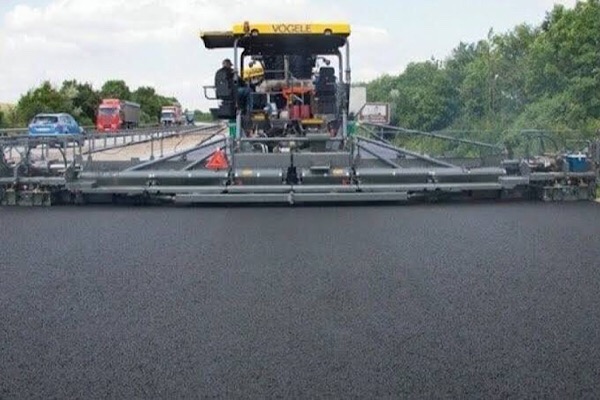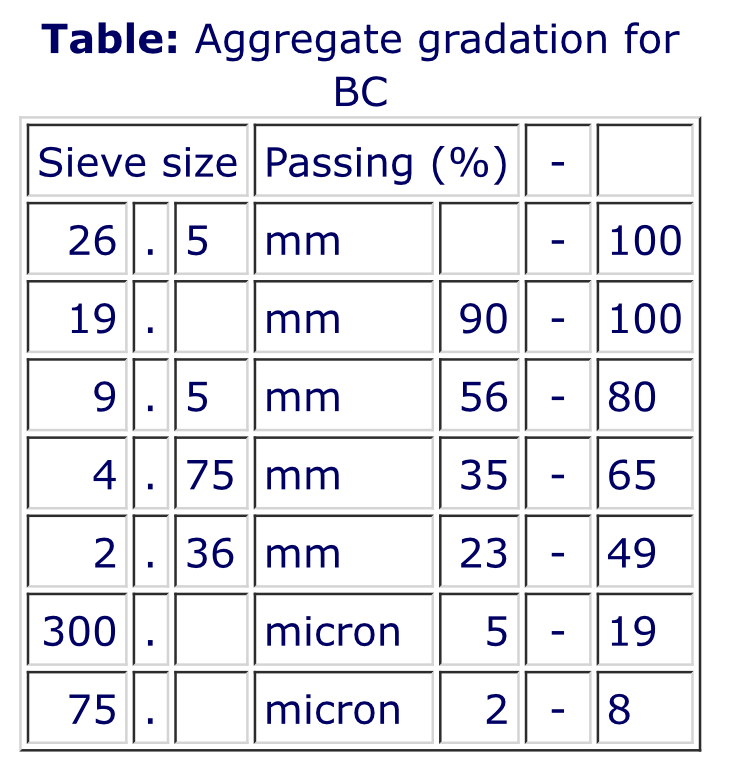Overview
The bituminous mix design aims to determine the proportion of bitumen, filler, fine aggregates, and coarse aggregates to produce a mix which is workable, strong, durable and economical. The requirements of the mix design and the two major stages of the mix design, i.e dry mix design and wet mix design will be discussed.
Evolution of road surface
Unsurfaced earthen roads, or cart-track
Unsurfaced earthen roads upgrades with natural soil from borrow pits and attention to drainage, and compaction is by traffic
Dry aggregate and sand-clays mix, in which the the former act as wear resistant and the latter as natural binder
Water-bound macadam, the above constituents, mixed together (pre-mix or in-situ) with water and compacted to improve the strength
Oiled roads, introduced to reduce dust by bitumen stabilized soils
Seal coat: the base course is protected from traffic and moisture by sealing the surface with a thin film of bitumen aggregate mix, which is structurally strong surface for pneumatic-tyred traffic. This is provided on firm and smooth base course after a tack coat using cutback bitumen or bitumen emulsions with a penetration of 5 mm.
Asphaltic concrete: Traffic and the axle configuration are increasing very much which raises demand for the new type of pavement which can meet the above requirements. The asphaltic concrete is one which is the high dense graded premix and it is termed as the highest quality pavement surface course.
Bitumen mix or asphalt mix overlays of minimum 20 – 40 mm to as high as 300 – 500 mm or even more.
Objectives of mix design
The objective of the mix design is to produce a bituminous mix by proportionating various components so as to have:
sufficient bitumen to ensure a durable pavement,
sufficient strength to resist shear deformation under traffic at higher temperature,
sufficient air voids in the compacted bitumen to allow for additional compaction by traffic,
sufficient workability to permit easy placement without segregation,
sufficient flexibility to avoid premature cracking due to repeated bending by traffic,and
sufficient flexibility at low temperature to prevent shrinkage cracks.
Constituents of a mix
Coarse aggregates: Offer compressive and shear strength and shows good interlocking properties. E.g. Granite
Fine aggregates: Fills the voids in the coarse aggregate and stiffens the binder. E.g. Sand, Rock dust
Filler: Fills the voids, stiffens the binder and offers permeability. E.g. Rock dust, cement, lime
Binder: Fills the voids, cause particle adhesion and gluing and offers impermeability. E.g. Bitumen, Asphalt, Tar
Types of mix
Well-graded mix:- Dense mix, bituminous concrete has good proportion of all constituents and are called dense bituminous macadam, offers good compressive strength and some tensile strength
Gap-graded mix:- Some large coarse aggregates are missing and has good fatigue and tensile strength.
Open-graded mix:- Fine aggregate and filler are missing, it is porous and offers good friction, low strength and for high speed.
Unbounded:- Binder is absent and behaves under loads as if its components were not linked together, though good interlocking exists. Very low tensile strength and needs kerb protection.
Different layers in a pavement
Bituminous base course Consist of mineral aggregate such as stone, gravel, or sand bonded together by a bituminous material and used as a foundation upon which to place a binder or surface course.
Bituminous binder course A bituminous-aggregate mixture used as an intermediate coarse between the base and surface courses or as the first bituminous layer in a two-layer bituminous resurfacing. It is sometimes called a leveling course.
Asphaltic/Bituminous concrete Bituminous concrete consists of a mixture of aggregates continuously graded from maximum size , typically less than 25 mm, through fine filler that is smaller than 0.075 mm. Sufficient bitumen is added to the mix so that the compacted mix is effectively impervious and will have acceptable dissipative and elastic properties.
Requirements of Bituminous mixes
Stability
Stability is defined as the resistance of the paving mix to deformation under traffic load. Two examples of failure are (i) shoving – a transverse rigid deformation which occurs at areas subject to severe acceleration and (ii) grooving – longitudinal ridging due to channelization of traffic. Stability depend on the inter-particle friction, primarily of the aggregates and the cohesion offered by the bitumen. Sufficient binder must be available to coat all the particles at the same time should offer enough liquid friction. However, the stability decreases when the binder content is high and when the particles are kept apart.
Durability
Durability is defined as the resistance of the mix against weathering and abrasive actions. Weathering causes hardening due to loss of volatiles in the bitumen. Abrasion is due to wheel loads which causes tensile strains. Typical examples of failure are (i) pot-holes, – deterioration of pavements locally and (ii) stripping, lost of binder from the aggregates and aggregates are exposed. Disintegration is minimized by high binder content since they cause the mix to be air and waterproof and the bitumen film is more resistant to hardening.
Flexibility
Flexibility is a measure of the level of bending strength needed to counteract traffic load and prevent cracking of surface. Fracture is the cracks formed on the surface (hairline-cracks, alligator cracks), main reasons are shrinkage and brittleness of the binder. Shrinkage cracks are due to volume change in the binder due to aging. Brittleness is due to repeated bending of the surface due to traffic loads. Higher bitumen content will give better flexibility and less fracture.
Skid resistance
It is the resistance of the finished pavement against skidding which depends on the surface texture and bitumen content. It is an important factor in high speed traffic. Normally, an open graded coarse surface texture is desirable.
Workability
Workability is the ease with which the mix can be laid and compacted, and formed to the required condition and shape. This depends on the gradation of aggregates, their shape and texture, bitumen content and its type. Angular, flaky, and elongated aggregates workability. On the other hand, rounded aggregates improve workability.
Desirable properties
From the above discussion, the desirable properties of a bituminous mix can be summarized as follows:
Stability to meet traffic demand
Bitumen content to ensure proper binding and water proofing
Voids to accommodate compaction due to traffic
Flexibility to meet traffic loads, esp. in cold season
Sufficient workability for construction
Economical mix
Summary
Bituminous mixes should be stable, durable, flexible, workable and should offer sufficient skid resistance. The mix consists of coarse and fine aggregates, filler and binder. It may be well graded, open graded, gap graded or unbounded as per the requirements. As far as possible, it should be economical also.
Problems
Granite is an example for
Coarse aggregate
Fine aggregate
Filler
none of these
Grooving is
deterioration of pavements locally
exposure of aggregate due to losing of bitumen
longitudinal ridging due to channelization of traffic
none of these
Solutions
Granite is an example for
Coarse aggregate$\surd$
Fine aggregate
Filler
none of these
Grooving is
deterioration of pavements locally
exposure of aggregate due to losing of bitumen
longitudinal ridging due to channelization of traffic$\surd$
none of these
https://www.civil.iitb.ac.in/tvm/1100_LnTse/408_lnTse/plain/plain.html











